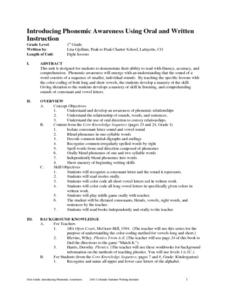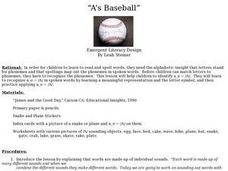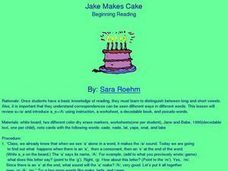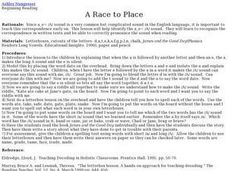Curated OER
Beat the Heat
Review common digraphs with your early elementary schoolers. They identify the digraph /ea/ in written and spoken language. After a brief discussion, they apply the rule for identifying and spelling words containing the /ea/ digraph....
Curated OER
Introducing Phonemic Awareness Using Oral and Written Instruction
First graders demonstrate their ability to read with fluency, accuracy, and comprehension through phonemic awareness. They use a color-coding system to master the long and short vowel sounds and develop their skills in listening and...
Curated OER
Wild for Watermelon
In this multiple skills worksheet, learners identify long and short vowel sounds in words and sequence the life cycle of a watermelon. Students write 14 answers.
Curated OER
Letter Sound Blending
Students play a game that asks them to blend sounds and differentiate between long and short vowels. They give clues to one student by sounding out all consonants and classifying the vowel as short or long. The student then blends the...
Achieve3000
Discriminating Phonemes
Develop the fluency of beginning readers one sound at a time with this phonemic awareness instructional activity. Through a series of whole-class instruction, independent practice, and collaborative learning activities,...
Achieve3000
Discriminating Phonemes 2
Some sounds sound very similar! Help your class learn how to distinguish between various sounds by following the steps outlined in this plan. The plan includes a warm-up, a teacher-led portion, and details for guided and independent...
Curated OER
A's Baseball
First graders distinguish between short vowel a and long vowel a. They are introduced to the vowel-consonant-e pattern that changes short vowel sounds into long vowel sounds. They practice reading words with the vowel-consonant-e pattern.
Curated OER
O No!
First graders distinguish between short vowel a and long vowel O. They are introduced to the vowel-consonant-e pattern that changes short vowel sounds into long vowel sounds. They practice spelling words with the vowel-consonant-e pattern.
Curated OER
Jake Makes Cake
Students distinguish between short vowel a and long vowel a. They are introduced to the vowel-consonant-e pattern that changes short vowel sounds into long vowel sounds. They practice changing words to long vowel sounds by adding an...
Curated OER
Phonics Jeopardy
In this phonics PowerPoint, 1st graders participate in a game show similar to "Jeopardy" in which they identify pictures that have a beginning sound corresponding to the given vowel pattern, blend, or digraph.
Curated OER
Beginning and Ending Sounds
First graders practice their letter and word recognition skills. In this initial and final sounds lesson plan, 1st graders participate in a classroom activity that requires them to blend phonemes into spoken words and sound out...
Curated OER
Who Knows the Letter?
Help learners identify initial consonant sounds and letters that represent that sound. They indicate awareness of consonant sounds and letters by responding with a physical movement. They also sing using "Sing Your Way Through Phonics"...
Curated OER
Peg and Hen
Young scholars navigate a website to practice the short e sound. In this short e sound lesson, students read a story on Starfall and complete practice with the short e sound.
Curated OER
The Doctor Sound
Learners recognize the short vowel o in written and spoken language. Through matching and listening activities, students discriminate the short vowel o from other short vowel sounds. They associate the phoneme with its letter...
Curated OER
Closed Syllables
Second graders, given 5 elephant words, divide the words into syllables by underlining the talking vowels, swooping, and pulling down consonants to find cutting pattern, and to explain that a single vowel represents the short vowel sound.
Curated OER
The Scary, Creaky Door
Learners recognize the short vowel e in written and spoken language. Through listening and matching activities, they discriminate the vowel sound /e/ from other phonemes. Students identify the phoneme and letter in pictures using a...
Curated OER
A Race to Place
Students distinguish between short vowel a and long vowel a. They are introduced to the vowel-consonant-e pattern that changes short vowel sounds into long vowel sounds. They practice spelling words with the vowel-consonant-e pattern.
Curated OER
Beginning and Ending Sounds
First graders practice the beginning and ending sounds of words. In this phonological awareness lesson, 1st graders use picture cards for one syllable words and pronounce each word. Students match other picture cards with the same...
Curated OER
Learn-to-Read Pumpkin Patch
Students practice identifying and pronouncing the short letter "u" sound. In this phonetic awareness instructional activity, students access the Starfall.com website and follow the directions on the screen to reinforce the short "u"...
Curated OER
Phonics: Words with More Than One Syllable (CV/C) Rule A
Knowing basic phonics rules can help learners increase their reading accuracy, pronunciation, and spelling. Third graders practice breaking or chunking words based on the cv/c syllable rule. They take note of where to break each word,...
Curated OER
Voicing and Syllable Length (Using Rubber Bands)
High schoolers identify voiced and unvoiced sounds. They practice using short and long vowel sounds. They identify consonants only after paying attention to the length of vowels. They use rubber bands to help them determine the...
Curated OER
Animal Alphabet
Students make a class animal book using the letters of the alphabet. They use a website imbedded in this plan to get pages with animals that begin with any of the 26 letters.
Curated OER
Make a Word: Long U by Starfall
Students explore language arts by participating an on-line grammar activity. In this letter U lesson, students discuss the uses for the letter U in the English language and the different sounds that can be made from the vowel. Students...
Curated OER
"Aaaaaa!!!!" It's Okay, Baby!!
Your kindergarten or first grade class works on recognizing the /a/ sound in spoken words. Use the fun tongue twister to help remember the target sound, and practice writing the letter a. Then have them write words that use this target...

























